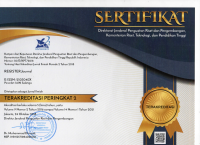Disaster mitigation and forest preservation in marind-anim literature
Abstract
Keywords
Full Text:
PDFReferences
Agung, W. (2015). Kajian Analisis Wacana Kritis Pada Cerita Bergambar Anak Dwi Bahasa Kura-Kura Si Penjaga Samudra (Turtle The Guard Of The Ocean), 04(01), 28–40.
Basilius, R. W., Martha, B., & Ermelinda, A. P. (2015). Factors influencing teachers’ organizational commitment (Case study on primary schools’ teachers in a remote area of Merauke regency, Papua, Indonesia). Journal of Educational Policy and Entrepreneurial Research, 2(10), 122–130.
Becker, C. D., & Ghimire, K. (2003). The synergy between traditional ecological knowledge and conservation science supports forest preservation in Ecuador. Ecology and Society, 8(1). https://doi.org/10.5751/es-00582-080101
Cámara-Leret, R., Schuiteman, A., Utteridge, T., Bramley, G., Deverell, R., Fisher, L. A., … Heatubun, C. (2019). The Manokwari declaration: Challenges ahead in conserving 70% of Tanah Papua’s forests. Forest and Society, 3(1), 148–151. https://doi.org/10.24259/fs.v3i1.6067
Chao, S. (2017). “There Are No Straight Lines in Natureâ€: Making Living Maps in West Papua. Anthropology Now, 9(1), 16–33. https://doi.org/10.1080/19428200.2017.1291014
Chao, S. (2019). The Plastic Cassowary: Problematic ‘Pets’ in West Papua. Ethnos, 84(5), 828–848. https://doi.org/10.1080/00141844.2018.1502798
Dods, R. R. (2002). The death of smokey bear: The ecodisaster myth and forest management practices in prehistoric North America. World Archaeology, 33(3), 475–487. https://doi.org/10.1080/00438240120107486
Garrard, G. (2004). Ecocriticism (New Critical Idiom). Retrieved from https://book.douban.com/subject/2479708/
Hendrawati, Y. (2011). Etika Lingkungan Dalam Mitos Dema-Totem-Klen Suku Marind-Anim Di Papua: Relevansinya Bagi Pelestarian Lingkungan Di Indonesia. Universitas Gadjah Mada.
Hogg, L., & Baal, J. Van. (1968). Dema: Description and Analysis of Marind-Anim Culture (South New Guinea). Man, 3(1), 160. https://doi.org/10.2307/2799470
Holden, A. (2003). In need of new environmental ethics for tourism? Annals of Tourism Research, 30(1), 94–108. https://doi.org/10.1016/S0160-7383(02)00030-0
Maryani, E. (2008). Model Sosialisasi Mitigasi Pada Masyarakat Daerah Rawan Bencana di Jawa Barat. Penelitian Hibah Dikti.
Muhammad, N., & Achmadi, J. (2007). Kearifan Budaya Lokasl dalam Perspektif Pengembangan Pertanian di Lahan Rawa. Banjar Baru,
Bogor: Balai Besar Sumber Daya Lahan Pertanian.
Nayar, P. K. (2010). Contemporary Literary and Cultural Theory: From Structuralism to Ecocriticism, 296. Retrieved from https://books.google.be/books?id=YhnRQLya90MC
Raymond, C. (2010). Headhunters from the Swamps: The Marind Anim of New Guinea as seen by the Missionaries of the Sacred Heart, 1905-1925. KITLV Press.
Warren, D.M, & Rajasekaran, B. (1993). Putting local knowledge to good use. International Agricultural Development, 4(13), 8–10.
Zamzami, L., & . H. (2014). Kearifan Budaya Lokal Masyarakat Maritim Untuk Upaya Mitigasi Bencana Di Sumatera Barat. Jurnal Antropologi: Isu-Isu Sosial Budaya, 16(1), 37. https://doi.org/10.25077/jantro.v16i1.18
DOI: https://dx.doi.org/10.30659/e.8.1.227-241
Refbacks
- There are currently no refbacks.
Copyright (c) 2023 Arin Mantara Anggawirya, Lastika Ary Prihandoko
License URL: https://creativecommons.org/licenses/by/4.0/










